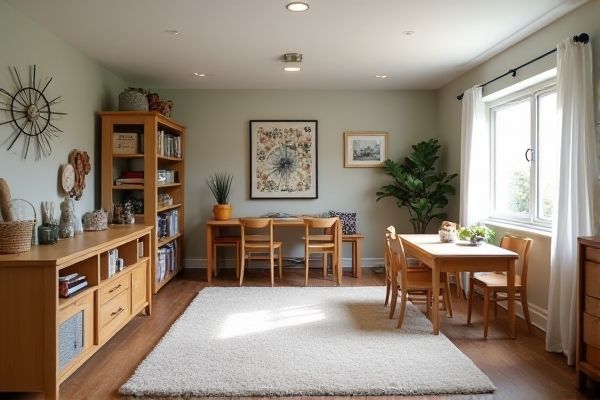
A craft room in the basement offers a dedicated space for creativity and organization, while a playroom provides a safe and fun environment for children to enjoy. Explore the rest of the article to discover which basement design best suits your family's needs and lifestyle.
Table of Comparison
| Feature | Craft Room Basement | Playroom Basement |
|---|---|---|
| Purpose | Workspace for crafts, DIY projects, and hobbies | Recreational area for children's games and activities |
| Furniture | Worktable, storage cabinets, shelving units | Soft seating, toy storage, play mats |
| Lighting | Bright, focused task lighting | Soft, ambient lighting for safety |
| Flooring | Durable, easy-to-clean flooring (vinyl, laminate) | Soft, cushioned flooring (foam mats, carpet) |
| Storage | Organized bins, drawers for craft supplies | Accessible bins for toys and games |
| Acoustics | Quiet, sound-absorbing materials preferred | Soundproofing for noise reduction |
| Safety | Safe storage for sharp tools and chemicals | Childproofing with rounded edges, gates |
| Ventilation | Good airflow to handle fumes from paints/glues | Well-ventilated for fresh air during play |
| Electrical Outlets | Multiple outlets for tools and lighting | Outlets with covers for child safety |
Understanding the Purpose: Craft Room vs Playroom
A craft room in the basement is designed to nurture creativity and organization by providing dedicated space for arts, sewing, and DIY projects with ample storage for supplies. In contrast, a playroom focuses on safety, open space, and kid-friendly features to encourage active play and imaginative activities. Understanding these distinct purposes helps optimize basement use according to family needs and lifestyle priorities.
Space Planning for Basements: Craft vs Play Areas
Craft rooms in basements require precise space planning to accommodate worktables, storage for supplies, and adequate lighting for detailed projects. Playrooms need open areas for movement, durable flooring, and safety features to create a child-friendly environment. Your layout should balance functional zones and accessibility to maximize the basement's potential for either creative crafts or active play.
Essential Features for Craft Room Basements
Craft room basements require ample natural and artificial lighting to ensure detailed work can be done comfortably, along with durable, stain-resistant flooring to handle craft materials. Organized storage solutions such as shelving units, pegboards, and drawers are essential to keep supplies sorted and accessible. Ventilation systems and sturdy worktables further enhance functionality, making the space efficient and conducive for creative projects.
Must-Have Elements for Playroom Basements
Playroom basements demand safety features like cushioned flooring and ample natural or artificial lighting to create a secure, inviting environment. Incorporating versatile storage solutions such as cubbies and shelves ensures organized space for toys and games, while vibrant, durable wall finishes stimulate creativity and withstand wear. Essential elements also include flexible seating arrangements and open areas that accommodate active play and social interaction.
Organization and Storage Solutions
Craft rooms benefit from modular storage units, wall-mounted pegboards, and clear containers to keep supplies easily accessible and neatly categorized. Playrooms in basements require durable, low-maintenance storage bins, open shelves, and labeled baskets for quick toy cleanup and safe organization. Your choice depends on prioritizing either detailed craft tool management or efficient, kid-friendly toy storage.
Safety Considerations: Kids vs Adults
Craft rooms designed for adults require secure storage for sharp tools, proper ventilation for fumes, and sturdy furniture to prevent accidents, ensuring a safe workspace. Playrooms in basements intended for kids must prioritize non-toxic materials, soft flooring to cushion falls, and childproof electrical outlets to minimize injury risks. Your choice should reflect tailored safety measures that address the specific needs of children or adults in the basement environment.
Design and Decoration Ideas
Craft rooms in basements benefit from bright, focused lighting and organized storage solutions such as pegboards and modular shelving to keep supplies accessible and tidy. Playrooms emphasize safety and comfort with cushioned flooring, vibrant wall murals, and versatile furniture that encourages creativity and active play. Both spaces can incorporate multi-functional zones and durable, easy-to-clean materials tailored to their specific uses.
Multi-Functional Basement Room Ideas
Transforming a basement into a multi-functional space combining a craft room and playroom maximizes usage by integrating storage solutions, workstations, and play areas. Utilizing modular furniture and wall-mounted shelving creates adaptable zones, allowing both creative projects and children's activities to coexist without clutter. Strategic lighting and durable flooring further enhance functionality, making the basement a versatile retreat for family creativity and play.
Budgeting for Craft and Playroom Basements
Craft room and playroom basements require separate budgeting strategies due to their distinct needs; craft rooms demand specialized storage solutions, durable work surfaces, and adequate lighting, while playrooms focus on safety features, soft flooring, and ample open space for activities. Your budget must allocate funds to high-quality materials for crafting tools or child-friendly finishes, balancing functionality with durability. Planning expenses early ensures your basement renovation maximizes both creativity and playfulness without overspending.
Final Decision: Choosing the Best Use for Your Basement
Determining the best use for your basement requires evaluating your lifestyle needs and space functionality; a craft room offers organized storage for supplies and a dedicated area for creative projects, while a playroom provides a safe, open environment for children's activities and development. Consider factors such as natural light availability, ventilation, and noise control to enhance the room's purpose. Prioritizing long-term usability and personal or family priorities ensures the basement is transformed into a space that maximizes both comfort and value.
 homyna.com
homyna.com